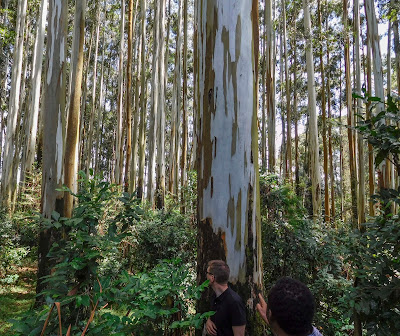Puun energiakäytön voi arvioida lisääntyvän maassamme kun fossiilipolttoaineille säädetään tulevaisuudessa entistä tiukempia ympäristömaksuja. Mutta aiheuttaako puun tarkempi korjuu uuden ympäristöongelman, johtaako pienpuun ja hakkuutähteen energiakäyttö metsämaamme köyhtymiseen? Jotta tulevaisuuden puiden kasvulta eivät loppuisi ravinteet, avuksi on otettava metsänlannoitteista luonnonmukaisin: energiapuun tuhka.
Puun energiakäyttö lähti maassamme nousuun vuonna 1977, ensimmäisen energiakriisin jälkeen. Se oli mahdollista, kun puun uusi korjuutekniikka oli tullut avuksi. Hakkeen läpimurto avasi metsäenergialle kanavat.
Aluksi polttohake valmistettiin karsitusta rangasta, mutta pian siirryttiin kokopuuhun kun huomattiin että järein konein rungot, latvukset ja oksat voi kaikki hakettaa. Hake-energian kehittäminen oli rivakassa vauhdissa etenkin 1980-luvun alkupuolella. Entistä tehokkaampia traktorikäyttöisiä hakkureita keksittiin. Automatisoituja hakelämpökeskuksia rakennettiin. Maaseudulle syntyi uutta työllisyyttä.
Puu energialähteenä 1990-luvulla
Hakepuun aktiivi tuottaminen polttoaineeksi jatkui aina vuoteen 1984, mutta sitten tapahtui käänne: metsätähteen ja metsähakkeen energiakäyttö kääntyi laskuun. 1980-luvun puolivälin jälkeen ote kotimaisesta energiasta lipesi, pääosaksi öljyn hinnan laskun myötä.
Etevä energiatekniikka (high tech) parantaa 1990-luvulla uudelleen energiapuun kilpailukykyä. Puun poltto on tullut uuteen tekniseen vaiheeseen kun entistä matalamman lämpötilan leijukerrospoltto on mahdollista yhä pienemmissä kattiloissa. Typen oksidit vähenevät, ja rikki – jota puussa on vain hiukkasen – saadaan uudella tekniikalla yhä tarkemmin talteen.
Suurissa laitoksissa tullaan siirtymään kombivoimatekniikkaan, missä puu kaasutetaan. Siitä tuotetaan ensisijaisesti sähköä, sivutuotteena lämpöä. Uusin tekniikka, paineistettu poltto, on jo koeajovaiheessa. Uuden tekniikan ansiosta energian saanto paranee ja sähkön tuotannon hyötysuhde nousee entisestään. Metsäbiomassaa ei tarvitse enää kuivattaakaan metsässä; uudet laitokset saavat energian talteen märkänä syötetystä puusta.
Mutta jo tällä vuosikymmenellä puun energiakäyttöä tulee edistämään eniten hiilidioksidikysymys ja pelätty kasvihuoneilmiö. Puuhan kuuluu niihin uudistuviin energiavaroihin, mitkä eivät lisää ilmakehän hiilidioksidin pitoisuutta. Mikä puuta poltettaessa savuaa hiilidioksidina taivaalle, palautuu metsän kasvaessa takaisin puihin.
Ruotsissa energiapuulle on jo annettu hiilidioksidin takia hintaetu. Vuoden 1991 alussa fossiilipolttoaineille säädettiin kasvihuonekaasumaksu, 16 penniä kilolta hiilidioksidia, polttoaineen päästöjen mukaan laskettuna. Maksu rasittaa eniten kivihiiltä, vähiten maakaasua.
Kasvihuonekaasumaksua ei määrätty puupolttoaineille eikä muillekaan biomassoille. Energiapuulle tuli kertaheitolla hintaetua yli 50 markkaa puun kiintokuutiolta. Energiapuun kaupan voi ennustaa käyvän tänä vuonna Ruotsissa.
Köyhtyykö maaperä?
Rinnan energiahakkeen käytön kasvamisen kanssa on kasvanut huoli kokopuun korjuun haittavaikutuksista: maaperän köyhtymisestä ja mahdollisesta häiriössä myöhemmässä metsänkasvussa. Huoli ei ole aiheeton. Kokopuuhakkeeksi korjattavan nuoren koivun jokaisen kiintokuution mukana metsästä viedään runsas kilo typpeä, puoli kiloa kaliumia, 150 grammaa fosforia ja vajaa kilo kalsiumia. Maaperä paitsi köyhtyy tärkeistä pääravinteista, myös happamoituu kalkin vähetessä.
Karuilla kankailla ja soilla, nopean ravinteiden menetyksen pelätään johtavan puuston kasvun heikkenemiseen, ja mikroravinteiden vähetessä kasvuhäiriöihin. Viljavilla mailla puiden juurilla on käytettävissä niin runsaasti ylimääräisiä ravinteita, että kokopuun korjuu ei johtane välittömiin kasvutappioihin. Mutta viljavilla maillakin puuston kasvu voi taantua pitkän ajan kuluessa.
Ravinteet jäävät tuhkaan
Haketta poltettaessa pääosa palamatonta jäännöstä, tuhka, on kasvien kivennäisravinteita. Itse asiassa tuhkaan jäävät puiden tarvitsemista ravinteista kaikki muut paitsi typpi ja rikki. Pienpoltossa ne poistuvat savukaasujen mukana, suurissa energialaitoksissa nekin saadaan pian kaikki talteen.
Puun tuhka on puun kasvua ajatellen oivallinen lannoite, koska se sisältää lähes kaikki puun tarvitsemat kivennäisaineet ja vieläpä oikeissa suhteissa.
Tuhkan vaikutus monipuolinen
Tuhkalannoitusta on maassamme tutkittu jo vuosikymmeniä. Tuhkalla on samanaikaisesti sekä pää- ja hivenravinnevaikutus että maan neutralointi- eli kalkitusvaikutus. Puun tuhkan kalkitusvaikutus on tärkein, se on jopa suurempi kuin kalkkikivijauheella.
Metsänlannoituksessa tuhkan käytöstä on saatu parhaat kokemukset turvemailla. Ojitettujen soiden tuhkalannoituskokeita on seurattu maassamme jo vuosikymmenen ajan. Eräs tunnetuimpia kokeita on Leppiniemen tuhkalannoituskoe Metsäntutkimuslaitoksen Muhoksen tutkimusaseman lähettyvillä.
Kalvakkaneva ojitettiin vuonna 1932, viljeltiin männylle 1934 ja lannoitettiin koivun tuhkalla vuonna 1947. Tuhkaa levitettiin toiselle ruudulle 8 tonnia/ha, toiselle 16 tn/ha. 41 vuoden kuluttua lannoituksesta vähemmän tuhkattu ruutu oli kasvanut 300 kuutiota ja enemmän tuhkattu ruutu 387 kuutiometriä hehtaarilla, kun tuhkaton ruutu oli kasvanut vain 12 kuutiota. Muhoksen koe, mikä on eräs Metsäntutkimulaitoksen kuuluisimpia, on vakuuttava näyttö tuhkan pitkäaikaisesta vaikutuksesta, vaikka koe lieneekin turpeen runsaasta luontaisesta typestä johtuva poikkeustapaus.
Miksi puuntuhkalla ei lannoiteta?
Puun tuhkan lannoitusvaikutus on kiistaton. Tuhkalannoitus on luomulannoitusta; tuhkalannoitusta vastaan ei protestoi kukaan. Tuhkaa on myös saatavana, ja sitä riittää - ainakin toistaiseksi. Miksi tuhkan lannoituskäyttö ei ole levinnyt?
Syitä on kaksi. Pölytuhkan levittäminen on työsuojeluongelma. Niin tiivistä traktorin hyttiä ei ole keksittykään etteikö hienojakoinen tuhka pölyäisi kuljetuksen ja levityksen aikana. Sitäpaitsi monet lämpölaitokset mieluusti sammuttavat kuuman tuhkan vedellä. Tuhka muuttuu lietteeksi, eikä sen levitys onnistu kalkitusvaunun tapaisilla koneilla.
Osittain sammutetun pölytuhkan levittämiseen tarkoitetut laitteet kehittyvät koko ajan. Uusimman tekniikan vaunu ei muituta enää kalkitusvaunua, vaan on metsätraktoripohjainen lietso. Levityksen suorittaa urakoitsija. Samaa peruskonetta käytetään muissakin metsäajoissa.
Toinen ongelma liittyy tuhkan rakeistamiseen; rakeistetulla tuhkallahan voisi lannoittaa samoin konein, samoin työsuojelumenetelmin kuin kauppalannoitteilla. Rakeisella tuhkalla pääsisi tarkkuuslannoitukseen.
Jotta tuhkarae muodostuisi puristuskoneessa, tuhkassa pitäisi olla jäljellä kasvien liima-aineita, kuten esimerkiksi rehurakeissa on luonnostaan. Liima-aineet taas ovat haihtuneet puun poltossa. Liima-aineita rakeeseen tulee siis lisätä. Yksi mahdollisuus on yhdistää karjanlanta ja tuhka. Tuhkan rakeistamista tutkitaan edelleen.
Suljettu kierto
Puun tuhka on tulevaisuuden lannoite, koska sillä pääsee suljettuun kiertoon. Toki tuhkankin ravinteet pitkällä ajanjaksolla kiertävät vaikka välissä olisi kaatopaikka ja joki. Ympäristön kannalta tulisi kuitenkin pyrkiä aina kiertoon joka on mahdollisimman suppea ja nopea. Siksi tuhkan fosforia ei saisi päästää kaatopaikalta vesistöön. Siksi tuhkan ravinteet pitäisi palauttaa tarkkuuslannoituksella takaisin puiden juurille.
1980-luvun alussa, kun puun tuhkan merkitystä tutkittiin muuna osana metsäenergian tutkimuksia, puu- ja kuorituhkan vuosituotanto oli noin 80 000 tonnia.
Pienpuun energiakäyttöä on aina tarkasteltava mahdollisten ravinteiden menetysten valossa. Puussa on nimittäin tuhkaa suhteellisesti sitä enemmän mitä pienempänä se poltetaan. Lehdettömän puun ravinteet ovat pääosaksi kuoressa, ja kuoren osuus pienpuussa on suuri.
Puolen vuosisadan maassamme suoritetut puuntuhkan lannoitustutkimukset osoittavat että suljettu ravinnekierto on mahdollinen. Sen puoleen puun energiakäyttöä voi lisätä.
VELI POHJONEN
Käsikirjoitus 18.11.1991









